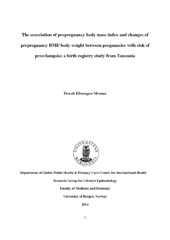| dc.description.abstract | Objective: Preeclampsia is among the three leading causes of maternal mortality and morbidity worldwide, occurs in 6-8% of all pregnancies, and is estimated to account for at least nine percent of maternal deaths in Africa. Studies from developed countries show that high prepregnancy BMI increases the risk of preeclampsia. We examined the association of prepregnancy body mass index and changes of prepregnancy body weight between pregnancies with risk of preeclampsia in the second pregnancy. In the term preeclampsia we also include cases of eclampsia. Method: A historic registry based study was used, analysing births registered in the Kilimanjaro Christian Medical Center (KCMC) birth registry between July 2000 and May 2013. Two sets of data were analysed; singleton births of gravida 1 or 2 mothers (n= 17, 750 births), and the linked first two recorded singleton births to a woman, irrespective of gravidity (n =3, 595 mothers). Prepregnancy BMI was categorized according to WHO categories underweight (less than 18.5), normal (18.5 - 24.9), overweight (25.0 - 29.9) and obese (30 or greater). Measured confounders were adjusted for in multivariable models. Results: Among the 17,750 singleton births, 9.1 % of the mothers were underweight, 24.0 % were overweight, and 7.4 % were obese. Five hundred and eighty-two pregnancies (3.3 %) were affected by preeclampsia. Compared to women of normal BMI, overweight and obese women had an increased risk of preeclampsia (AOR 1.5 (95%CI 1.2 - 1.7 and, 1.7(1.2 - 2.1), respectively, while underweight was protective (AOR 0.8 (0.8 - 1.1). Among 3,595 mothers without preeclampsia in their first recorded pregnancy, incidence of preeclampsia was 2% in the second recorded pregnancy. Weight loss, but not weight gain between the pregnancies was associated with risk of preeclampsia in the last pregnancy. The effect of weight change did not change after adjustment for BMI in second pregnancy. Conclusion: The association between prepregnancy body mass index and preeclampsia in this population of pregnant women in Northern Tanzania corresponds with earlier findings from developed countries. Overweight and obesity should be considered an obstetric risk factor is this population. | en_US |
